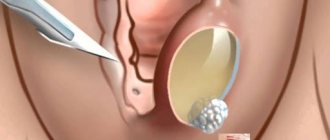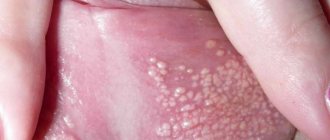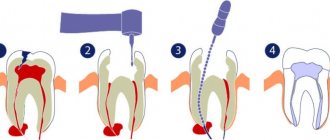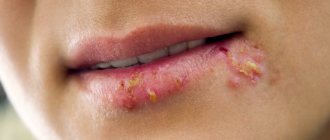Many women try to squeeze out the strange formation that they find on their labia. This should not be done; atheroma has a capsule that fits tightly to the tissues. It is impossible to remove this membrane on your own, and if it persists, a relapse will occur. In addition, it is easy to introduce germs at home, and the infection can result in serious complications.
If the cyst is very large or has sharply increased in size, you should immediately go to the doctor. Even when the formation does not cause discomfort, does not hurt or itch, the risk of infection increases. In modern medicine, there are different methods of treating atheroma that allow you to forget about the problem forever.
Lump on the labia majora
Most often, inflammation in the form of a lump on the labia majora is a symptom of inflammation of the Bartholin gland. This organ is paired; it precedes the entrance to the vagina. The organ consists of sebaceous and sweat glands and its main functions are to secrete a lubricant during sexual intercourse and moisturize the vagina to protect it from harmful microbes.
Photo 1: Only women who have reached puberty are susceptible to inflammation of the Bartholin gland. Source: flickr (GB SINGH)
If these glands become blocked, a lump-shaped tumor may appear on the labia. It is accompanied by redness and may be painful and itchy. Additional symptoms characteristic of this disease:
- painful compaction on both sides at the entrance to the vagina;
- burning in the perineal area;
- pain that worsens during sexual intercourse;
- temperature increase.
Inflammation of the Bartholin gland is primarily acute. If you do not engage in treatment, then this process can become chronic, and the doctor will diagnose a Bartholin gland cyst.
Bartholinitis in chronic and acute forms can be successfully cured without surgery; to do this, you need to contact a gynecologist at the first unpleasant symptoms of the disease and follow all the doctor’s recommendations.
Reasons for the appearance of a lump on the labia:
- decreased immunity;
- long-term use of antibiotics;
- chronic infection, such as tonsillitis;
- tight underwear;
- poor intimate hygiene;
- promiscuous sex life;
- infection during surgery.
The appearance of lumps on the labia can be symptoms of diseases such as prolonged vaginal candidiasis and vaginitis (inflammation of the vagina).
Vaginitis is a disease that also occurs due to poor hygiene, infection with worms, diseases of the endocrine system, and prolonged use of antibiotics. May be a consequence of diseases of the internal genital organs. For example, the same candidiasis, colpitis, etc.
Bartholin gland cyst - symptoms and treatment
Small asymptomatic cysts do not need to be treated. They are usually removed only for cosmetic purposes. Only large cysts - from 3 cm or more, which not only disrupt the aesthetic appearance of the external genitalia, but also interfere with everyday activities and sexual life - are subject to surgical treatment.
There is no point in simply opening or puncturing a cyst or abscess. This can lead to relapse, since the edges of the tissues, when punctured or incised, very quickly close again due to the rapid healing process [6].
The main goal of surgical treatment is to preserve the Bartholin gland and its functionality, and to form a channel for the outflow of secretions. There are several treatment options. Let's look at each of them.
Installation of Word catheter
This is a modern method of surgical treatment of cysts. This is especially relevant for its relapses.
Under local anesthesia, the cystic area is opened with a small incision of about 5 mm, after which its contents are removed and sent for bacteriological examination, and then the cyst cavity is washed and a Word catheter is installed into it. It is a silicone tube 55 mm long and 5 mm in diameter, inside of which there is a channel with thinner walls at the end. By inflating its rubber tip to 3 ml with saline solution of 0.9% sodium chloride, the doctor fixes the catheter in the cavity of the cyst. For better fixation and prevention of loss during movements, it is recommended to apply 2-3 absorbable interrupted sutures along the contour of the exiting part of the catheter. The second end of the catheter is inserted into the vagina.
The catheter remains in the cyst cavity for six weeks. This is necessary to form a channel for the passage of secretions, the walls of which will not grow together. The study shows that the Word catheter is easy to use, inexpensive to install, and has acceptable short-term relapse rates [7].
While the catheter is in the cyst cavity, the patient is advised to have sexual rest to avoid its loss. In some countries, there is no such restriction, since studies have shown that the pain symptom caused by both the cyst itself and the presence of a catheter in its cavity completely disappears by the sixth day [8].
As an alternative, a Jacobi ring . This catheter is more solid, it does not have a channel and is presented in the shape of a ring. It is installed through two punctures in the mucosa and capsule of the cyst, and then the two ends of the catheter are secured to each other.
Opening and draining the cyst
Under local infiltration or intravenous anesthesia, the cyst is opened, the cavity is washed with antiseptic solutions, then a rubber drainage is installed in it to drain the secretions. The effect of such an operation is low due to the rapid healing of the incision site and the cessation of outflow from the gland. It can be used only if there is no other method of treatment available or if the cyst has transformed into a Bartholin gland abscess.
Puncture of the cyst
It is performed by puncturing the cyst itself with a needle and then suctioning out its contents. This method of manipulation is carried out in pregnant women or when surgery is impossible.
Marsupialization of the cyst
This type of treatment involves opening the cyst, removing the secretion and creating a new duct. It is used in the following cases:
- if the cyst reappears despite treatment using a Word catheter;
- with a small cyst size;
- if the cyst has several chambers;
- if it is impossible to install a Word catheter.
Marsupialization of a cyst is a simple outpatient procedure. It is performed under local anesthesia for 20-30 minutes. An oval flap 1.5 cm long is cut out in the most convex part. The cyst itself is dissected in the same way, after which it is cleaned and washed. Then the cyst wall is sutured to the labial mucosa so that an artificial duct is formed [13]. The wound does not need to be sutured, as it will heal on its own.
On the second day after surgery, the patient is shown warm sitz baths, and on the third day, stool softeners are prescribed. They are necessary for the prevention of constipation, since hard stool increases pain in the postoperative area, and its stagnation in the colon contributes to the accumulation of harmful microbes that can penetrate through the tissues into the postoperative area. Sometimes antibiotics are prescribed based on the results of a microbiological study. Sexual activity can be resumed in the fourth week after surgery.
The likelihood of relapse after marsupialization is extremely low - about 10%. The operation itself can be performed several times, as it is simple and less traumatic compared to complete removal of the Bartholin gland.
CO2 laser
CO2 laser surgery is also an effective way to treat cysts and can be performed on an outpatient basis. A skin incision is made with a focused laser beam, then the capsule is opened to remove the contents of the cyst, followed by internal evaporation of the damaged capsule [9].
Carbon dioxide provides complete healing in an average of 22 days, with no scars, hematomas or wound infections. You can return to everyday life in about two days. Patients undergoing traditional surgery require 14 days to return to daily activities and 28 days for the surgical wound to heal completely [10]. Due to this, and the minimal risk of complications that may occur during or after surgery, CO2 laser surgery is more cost-effective than traditional treatment [10].
Gland removal
If the cyst recurs frequently with the formation of an abscess, doctors recommend removing the cyst along with the gland [13]. The operation requires great experience and accuracy of the surgeon. It is performed under intravenous anesthesia. Most often performed in a hospital setting.
The incision is made outward from the labia minora, since the opposite side of the mucosa is usually thin, which is why the cyst capsule can be accidentally cut. The cyst is carefully removed using gauze pads while moving away the incised tissue. The gland is also removed. The wound is sutured in layers with absorbable sutures. It is very important to remove the entire gland. Incomplete removal may cause recurrence of the cyst or abscess. If the other Bartholin gland functions normally, then there will be no problems with secretion after this operation.
It should be understood that during the operation the cyst capsule may rupture. This can slow down the duration of the operation and lead to contamination of the wound. Also, the operator may encounter bleeding from the vessels of the cyst bed, but it is easily stopped by applying submersible sutures.
After removal of the Bartholin gland, a rectovaginal fistula may occur - a pathological canal between the rectum and vagina. It appears as a result of ongoing inflammation and “melting” of surrounding tissues.
In this case, patients may complain of pain in the perineal area, which occurs during sexual intercourse and bowel movements. To establish and confirm the diagnosis, you need to contact a coloproctologist, undergo a gynecological and rectovaginal examination, as well as additional examinations. The tissue defect is eliminated using an autograft, a biological collagen plug or a titanium clip. If a fistula is detected during pregnancy, then natural childbirth is prohibited.
Seal on the labia minora
The lump on the labia minora is not related to bartholinitis. Often, pea-sized bumps and pustules occur when several reasons come together:
- poor perineal hygiene;
- hot season;
- unsuitable gaskets.
Compaction can also occur due to:
- hypothermia;
- cycling;
- inflammation of the hair follicle.
A wen appears on the labia minora, which, when ripe, bursts and pus comes out. To avoid the formation of infection, it is necessary to treat the seal with a disinfectant.
Important! A lump that appears on the labia minora may not cause discomfort at all, but any subcutaneous formation with pus risks the fact that this fluid may not come out and infect the internal tissues. Therefore, consultation with a doctor is necessary.
Therapy in all cases will depend on the diagnosis of a particular type of disease. The doctor may prescribe antibiotics or prescribe local antiseptics, and recommendations on wearing underwear and maintaining personal hygiene are also required.
Homeopathic treatment
Homeopathic treatment for lumps on the labia will also depend on the identified disease.
- If this is inflammation of the Bartholin glands, then Belladonna or Mercurius solubilis is . These drugs relieve redness and swelling of intimate organs, eliminate suppuration, and help shrink lymph nodes.
- For bacterial vaginitis with discharge, itching and burning of the genitals, Kalium bichromicum is . This remedy eliminates pain and helps healing in complex diseases and inflammations of the skin and mucous membranes.
- For vaginal discharge with a sharp, unpleasant odor, Kreosotum . This remedy eliminates burning sensation in the vulva, between the labia, in the vaginal area and removes discharge.
- The drug Silicea is prescribed for sluggish chronic inflammatory processes, abscess.
- Hepar sulfur (Hepar sulfur); – blocks purulent inflammation in the mucous membrane, helps with herpes. The product also removes burning sensation in the genital area and discharge.
When dense formations appear on the labia, therapy almost always has a favorable prognosis, but you should not self-medicate; first of all, consultation with a specialist is required. He will select the appropriate drug and prescribe the required dosage. The success of therapy depends on the correct choice of drug.
Why does atheroma occur?
The most common cause of blockage of the sebaceous gland ducts on the labia is increased oiliness of the skin. In this case, too much secretion is produced, it is difficult to remove from the glands and accumulates in the ducts. A similar situation occurs with excessive sweating, because the ducts of both types of glands are nearby.
Atheromas often occur with endocrine disorders. Hormonal imbalance affects secretion, activates the sebaceous glands, and increases the risk of cysts on the skin. Endocrinological problems are often diagnosed in obese women. Atheromas and cysts on the labia appear in patients with impaired synthesis of thyroid hormones (hypothyroidism), as well as in both types of diabetes mellitus.
The disease can be provoked by skin injuries during epilation or depilation, violations of hygiene rules, the use of inappropriate or low-quality cosmetics, and the influence of unfavorable environmental factors. The condition of the skin directly depends on the type of nutrition. In women whose menu consists of fatty, spicy dishes, and sweets, atheromas form more often. Risk factors are smoking and alcohol abuse.
To avoid the occurrence of atheroma on the labia, you need to promptly treat systemic pathologies, correct hormonal levels, eat right, adhere to hygiene, and lead a healthy lifestyle. If a formation is detected in the genital area, you should not self-medicate.
A cyst on the labia can easily be confused with a pimple. It is easy to distinguish between these two formations upon close examination, but it is impossible to do this on your own. Therefore, there is no need to squeeze out a suspicious lump, even if it is an ordinary pimple, it can easily cause an infection.
It's best to go to a dermatologist right away. The doctor will quickly make a differential diagnosis between atheroma and pimple. Inside the cyst there is always yellow content, which is easily visible through the thin skin of the labia. Palpation of the atheroma does not cause pain, its structure is dense, the skin around the formation is without signs of swelling and redness.











